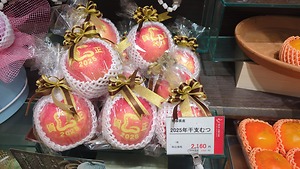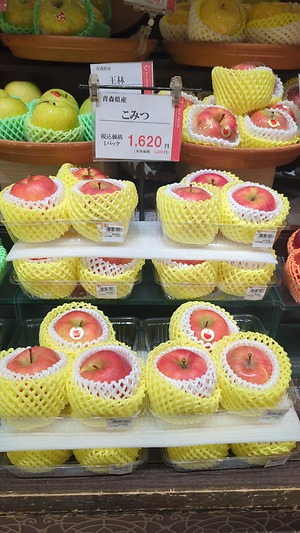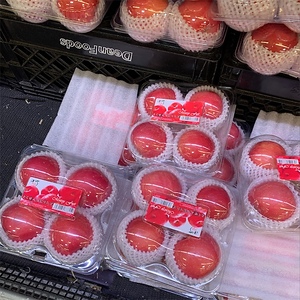


Red Mutsu Apples
Estimated Inventory, lb : 0
Description/Taste
Red Mutsu apples are large fruits with a round to conical, slightly lopsided shape. The skin is smooth, glossy, and waxy, ripening from pale green-yellow to bright red when mature, and prominent white spots may be visible across the surface. Underneath the skin, the flesh is white to ivory, crisp, aqueous, and coarse, encasing a central core filled with tiny, black-brown seeds. Red Mutsu apples are highly aromatic and crunchy with a sweet-tart, honeyed, and subtly acidic flavor.
Seasons/Availability
Red Mutsu apples are harvested in the fall and can be stored through the early spring.
Current Facts
Red Mutsu apples, botanically classified as Malus domestica, are a mid-season variety that belongs to the Rosaceae family. The cultivar was created in Japan, named after the Mutsu province, and is a cross between a golden delicious and an indo apple. There are multiple types of mutsu apples with varying skin tones, depending on how the apple is cultivated. Red Mutsu apples are created by placing a bag around the fruit to prevent sunlight from penetrating the skin. When the apples are approximately thirty days from being harvested, the bag is removed, and the pale green skin transforms into a bright red hue when exposed to sunlight. In Japan, Red Mutsu apples are considered to be one of the rarer mutsu types and fetch high prices in the market due to the extensive labor involved in cultivation. Despite their cost, the red apples are highly desired as a specialty cultivar and are primarily consumed as a dessert variety to showcase the unique coloring.
Nutritional Value
Red Mutsu apples are a good source of vitamins A and C, which are antioxidants that can boost the immune system, repair cell damage, and increase collagen production. The fruits also contain fiber, which can help regulate the digestive tract and provide smaller amounts of potassium, calcium, and iron.
Applications
Red Mutsu apples are best suited for raw applications as their red coloring and sweet-tart flesh are showcased when consumed fresh, out-of-hand. The crisp flesh can be sliced and eaten with nut butter, spreads, and dips, quartered and served with fruits and cheeses on appetizer plates, or even dipped whole in candy coatings or chocolate as a dessert. Red Mutsu apples can also be chopped and added to green and fruit salads, sliced and layered into sandwiches, or pressed into juices and ciders. In addition to fresh preparations, the coarse flesh can be dried for extended use or sometimes baked into bread, pies, cobblers, and muffins. Red Mutsu apples pair well with cranberries, pears, grapes, maple syrup, spices such as cinnamon, nutmeg, and cloves, honey, dark chocolate, caramel, and vanilla. The fresh fruits will keep 3-6 months when stored whole and unwashed in the crisper drawer of the refrigerator.
Ethnic/Cultural Info
In Japan, Red Mutsu apples are sometimes known as the “emoji apple” and are sold with designs grown onto the skin. During cultivation, stickers with words, shapes, and logos are placed on the skin. When the pale-yellow apple is removed from its bag and is exposed to sunlight, the portion of the skin being covered by the sticker will remain yellow while the remaining part of the skin will turn bright red. Popular patterns for Red Mutsu apples include pictures of Santa, pictures of the seven lucky gods, and kotobuki letters, and the designed apples are primarily sold during holidays such as new years and Christmas. Many Japanese locals purchase these apples as a whimsical gift and give the decorated fruit to friends and family as a sign of goodwill, friendship, and blessings.
Geography/History
Mutsu apples were developed at the Aomori Research Station, located in Kurioshi, Japan, in the 1930s. The variety is a hybrid of indo apples and golden delicious apples, and there are multiple color variations of the apple found within Japanese markets. Today Red Mutsu apples are considered to be one of the rarer mutsu varieties and are primarily found in Japan, cultivated in the Aomori, Fukushima, and Iwate prefectures.
Recipe Ideas
Recipes that include Red Mutsu Apples. One
| Call Me Cupcake |
|
Apple Frangipane Honey Tart |











